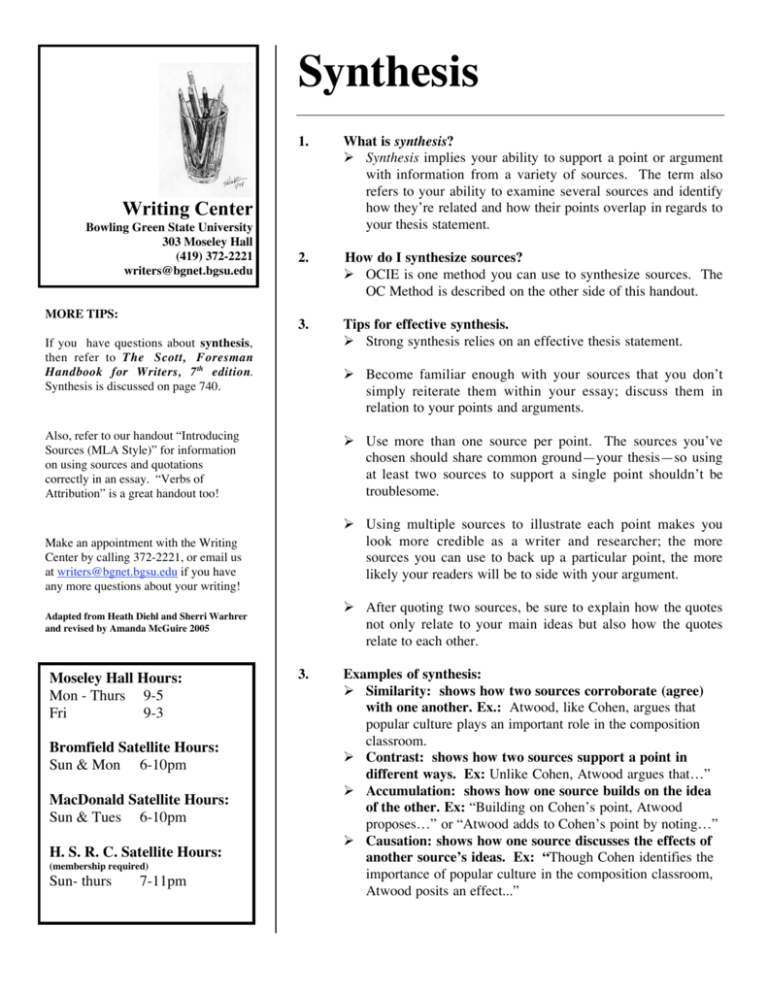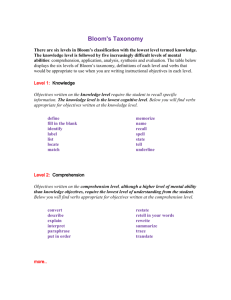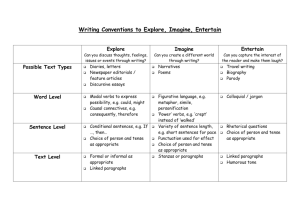Synthesis - Bowling Green State University
advertisement

Synthesis 1. What is synthesis? ÿ Synthesis implies your ability to support a point or argument with information from a variety of sources. The term also refers to your ability to examine several sources and identify how they’re related and how their points overlap in regards to your thesis statement. 2. How do I synthesize sources? ÿ OCIE is one method you can use to synthesize sources. The OC Method is described on the other side of this handout. 3. Tips for effective synthesis. ÿ Strong synthesis relies on an effective thesis statement. Writing Center Bowling Green State University 303 Moseley Hall (419) 372-2221 writers@bgnet.bgsu.edu MORE TIPS: If you have questions about synthesis, then refer to The Scott, Foresman Handbook for Writers, 7 th edition. Synthesis is discussed on page 740. ÿ Become familiar enough with your sources that you don’t simply reiterate them within your essay; discuss them in relation to your points and arguments. Also, refer to our handout “Introducing Sources (MLA Style)” for information on using sources and quotations correctly in an essay. “Verbs of Attribution” is a great handout too! ÿ Use more than one source per point. The sources you’ve chosen should share common ground—your thesis—so using at least two sources to support a single point shouldn’t be troublesome. ÿ Using multiple sources to illustrate each point makes you look more credible as a writer and researcher; the more sources you can use to back up a particular point, the more likely your readers will be to side with your argument. Make an appointment with the Writing Center by calling 372-2221, or email us at writers@bgnet.bgsu.edu if you have any more questions about your writing! ÿ After quoting two sources, be sure to explain how the quotes not only relate to your main ideas but also how the quotes relate to each other. Adapted from Heath Diehl and Sherri Warhrer and revised by Amanda McGuire 2005 Moseley Hall Hours: Mon - Thurs 9-5 Fri 9-3 Bromfield Satellite Hours: Sun & Mon 6-10pm MacDonald Satellite Hours: Sun & Tues 6-10pm H. S. R. C. Satellite Hours: (membership required) Sun- thurs 7-11pm 3. Examples of synthesis: ÿ Similarity: shows how two sources corroborate (agree) with one another. Ex.: Atwood, like Cohen, argues that popular culture plays an important role in the composition classroom. ÿ Contrast: shows how two sources support a point in different ways. Ex: Unlike Cohen, Atwood argues that…” ÿ Accumulation: shows how one source builds on the idea of the other. Ex: “Building on Cohen’s point, Atwood proposes…” or “Atwood adds to Cohen’s point by noting…” ÿ Causation: shows how one source discusses the effects of another source’s ideas. Ex: “Though Cohen identifies the importance of popular culture in the composition classroom, Atwood posits an effect...” The OC Method 1. Writing Center Bowling Green State University 303 Moseley Hall (419) 372-2221 writers@bgnet.bgsu.edu 2. TIPS: If you are still having questions about verbs of attribution, then refer to your Scott, Foresman Handbook, 7th edition. Verbs of attribution are discussed on page 753 and listed on Chart 50.1. Also, refer to our handout “Introducing Sources (MLA Style)” for information on using sources and quotations correctly in an essay. Make an appointment with the Writing Center by calling 372-2221, or email us at writers@bgnet.bgsu.edu if you have any more questions about your writing! Revised by Amanda McGuire 2005 3. Moseley Hall Hours: Mon - Thurs 9-5 Fri 9-3 Bromfield Satellite Hours: Sun & Mon 6-10pm MacDonald Satellite Hours: Sun & Tues 6-10pm 4. H. S. R. C. Satellite Hours: (membership required) Sun - Thurs 7-11pm What is The OC Method? ÿ The OC Method is a writing strategy designed to help students build more fully developed, logically organized, and effectively synthesized paragraphs. The OC Method stands for the steps of OBSERVE, CITE, INTERPRET, CITE INTERPRET, and EVALUATE, which helps students synthesize sources and develop main ideas. What are the basic steps of The OC Method? 1) OBSERVE: in your own words, provide a topic sentence that clearly and directly states the focus of the paragraph. Refer to the thesis statement ÿ Add ÿ Admit ÿ Affirm ÿ Allege ÿ Argue ÿ Believe ÿ Confirm ÿ Deny ÿ Disagree ÿ Emphasize ÿ Insist ÿ Mention ÿ Posit ÿ Propose ÿ Reveal ÿ State ÿ Say ÿ Think ÿ Verify How do you know which verb of attribution to use? ÿ As with so many things in writing, it depends on context. ÿ In an argumentative essay, try verbs like affirm, argue, confirm, deny, disagree, and verify, where applicable. ÿ For research essays, try introducing a quotation or paraphrase with verbs like add, reveal, state, mention, or say. ÿ If you mean to point out that a writer has really accentuated a point, try emphasize. If you are dubious about what the author is writing and plan to disagree, try allege or claim. Different verbs are warranted in different contexts, so have as many at your fingertips as possible. What verb tense do attributions use? ÿ MLA style usually requires that you use the present tense (e.g., the speaker(s) argues or argues) for sources cited. ÿ APA style usually requires that you use the past tense (e.g., the speaker(s) argued) or present perfect tense (e.g., the speaker(s) has or have argued) for sources cited. Remember: being consistent with verb tense is really important.






